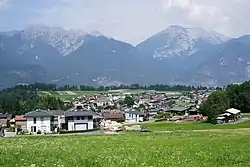Ranggen
Ranggen is a municipality in the district of Innsbruck-Land in the Austrian state of Tyrol located 12 km west of Innsbruck. The location was mentioned as “Fergen” in 1482 for the first time. Ranggen has 17 parts.
Ranggen | |
|---|---|
 View of Ranggen | |
 Coat of arms | |
 Ranggen Location within Austria | |
| Coordinates: 47°15′27″N 11°12′40″E | |
| Country | Austria |
| State | Tyrol |
| District | Innsbruck Land |
| Government | |
| • Mayor | Manfred Spiegl |
| Area | |
| • Total | 6.97 km2 (2.69 sq mi) |
| Elevation | 826 m (2,710 ft) |
| Population (2018-01-01)[2] | |
| • Total | 1,072 |
| • Density | 150/km2 (400/sq mi) |
| Time zone | UTC+1 (CET) |
| • Summer (DST) | UTC+2 (CEST) |
| Postal code | 6175 |
| Area code | 05232 |
| Vehicle registration | IL |
| Website | www.ranggen.at |
Population
| Year | Pop. | ±% |
|---|---|---|
| 1869 | 361 | — |
| 1880 | 347 | −3.9% |
| 1890 | 355 | +2.3% |
| 1900 | 346 | −2.5% |
| 1910 | 344 | −0.6% |
| 1923 | 348 | +1.2% |
| 1934 | 357 | +2.6% |
| 1939 | 342 | −4.2% |
| 1951 | 364 | +6.4% |
| 1961 | 400 | +9.9% |
| 1971 | 479 | +19.8% |
| 1981 | 569 | +18.8% |
| 1991 | 703 | +23.6% |
| 2001 | 839 | +19.3% |
| 2011 | 972 | +15.9% |
| 2018 | 1,072 | +10.3% |
Geography
Ranggen is situated in a hollow of the Inn valley terrace, west of Innsbruck or in the eastern continuation of the Inzinger mountain. The actual Ranggen village area is divided into an outer, upper and lower village. In addition, there are alley-like condensations and hamlets that characterize the image of the cultural landscape. A special feature of the settlement geography is the Ferklehen manor (located on the valley floor near Unterperfuss), whose name is derived from "Fergen", which originally meant the right to look after the Inn ferry at Zirl. After the construction of the Inn bridge (1482), the Fergen right then referred to bridge maintenance. The Rettenbach flows through Ranggen. The highest mountain is the Rangger Köpfl with 1939 m.
History
In the Middle Ages and early modern times, the Premonstratensian monastery of Wilten (Innsbruck) had significant possessions in Ranggen. It kept its own archive drawer for this under the designation "Lutzlranggen" (from Middle High German lützel, lützelig = small, little), which is linguistically depicted today in the local place of Itzlranggen.
References
- "Dauersiedlungsraum der Gemeinden Politischen Bezirke und Bundesländer - Gebietsstand 1.1.2018". Statistics Austria. Retrieved 10 March 2019.
- "Einwohnerzahl 1.1.2018 nach Gemeinden mit Status, Gebietsstand 1.1.2018". Statistics Austria. Retrieved 9 March 2019.